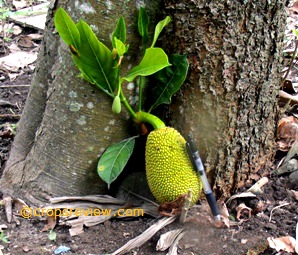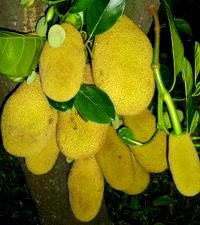Jackfruit or jack (Artocarpus heterophyllus), also known as jacquier, kathal, langka, nangka, khanun, makmi, banun, nongko, kapiak and peignai, is a plant that probably originated from the Western Ghats in India.
It has become naturalized in many tropical countries, mostly in Southeast Asia where it is considered a major fruit.
Where food is scarce, it is utilized as a staple.
This fruit crop is adapted to warm and humid climates below 1000 masl, but it can thrive up to 1600 meters.
It has a poor cold, drought, and flooding tolerance but has moderate tolerance to wind and salinity.
It favors an annual rainfall of 1500 mm or more without a pronounced dry season.
It grows on various types of soil but prefers deep, well-drained, alluvial, sandy, or clay loam soils with a pH range of 6.0 to 7.5.
This plant is described as a medium-sized, evergreen, monoecious tree up to 20 meters tall and 80 cm in diameter.
It produces fruits that are very green or greenish-yellow when ripe, hanging on short stalks from the main stem or large older branches.
The fruits are botanically a syncarp, up to 100 cm x 50 cm in size. Seeds are numerous.
A well-developed fruit may contain up to 500 seeds, each weighing 3-6 grams.

Sometimes fruits develop from the base of the trunk of jackfruit close to the ground
Practically all parts of the jackfruit plant are useful, from roots to leaves.
The latex of the tree is used as birdlime.
If heated, it makes an excellent cement for broken China.
The bark has been made into rope and cloth. Many parts of the tree have been used traditionally as medicine.
The timber is likewise classified as a medium hardwood with superior qualities for furniture, construction, musical instruments, and other uses.
However, this tree is more popular because of its large fruit which can weigh from 0.5 to 50 kg each.
It is used in many ways.
The pulp of the young fruit is cooked as a vegetable, pickled, or canned in brine or curry.
The pulp or flesh of the ripe fruit is eaten fresh or processed into chutney, jam, jelly, paste, or candy.
It is also used to flavor ice cream and beverages, made into honey, processed into concentrate or powder, and used in preparing drinks.
The seeds are commonly eaten after boiling or roasting.
In countries outside of the producing regions, jackfruit is available either in canned, packed, or dried forms.
There are now many companies engaged in producing dried jackfruit chips.
In Southeast Asia, this fruit is occasionally planted as an intercrop to coconut, durian, and mango.
They are also used as shade trees for coffee and black pepper.

There are several varieties that are grown in the Philippines. The most important is the Sinaba and the Tinumbaga.
Sinaba has thick flesh and small seeds, with good eating quality.
Tinumbaga has thinner flesh and a stronger aroma, with a sweeter taste.
Other varieties are called AES Jak #1, AES Jak #2, AES Jak #3, and ACC #4 Burabod.
These varieties have average fruit weights ranging from 5.2 to 12.3 kg. (AFIS, n.d.)
In South India, the jackfruits are divided into two main classes, the koozha chakka and the koozha pazham.
Koozha chakka has small, fibrous, soft and mushy but very sweet flesh while koozha pazham has crisp, higher-quality flesh.
Koozha chakka is equivalent to the khanun lamoud in Thailand, vela in Sri Lanka, and nangka bubur in Indonesia and Malaysia.
Koozha puzham is called khanun nang in Thailand, varaka in Sri Lanka, nangka salak in Indonesia, and nangka bilulang in Malaysia.
Flowering starts at the age of 2-8 years for trees propagated from seed.
Vegetatively propagated trees start fruiting within 2-4 years after planting under favorable conditions.
In Malaysia, clonal trees reach full production when they are 8 to 15 years old.
The trees bear flowers and fruits year-round under favorable conditions, but usually, there are peak harvest periods: from April to August or September to December in Malaysia, from January to May in Thailand, and during summer in India. (Verheij and Coronel, 1992).
Fruits ripen 3-8 months after flowering (SCUC, 2006).
The average yield of jackfruit is about 70-100 kg per tree per year in Malaysia and the Philippines (Verheij and Coronel, 1992).
With a planting density ranging from a minimum of 70 to a maximum of 180 trees per hectare, this is equivalent to an annual yield potential of 4.9-18 tons per hectare.
According to SCUC (2006), however, the average yield is about 10 tons per hectare.
